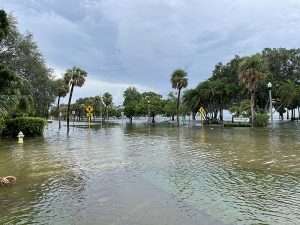US Storms Get Billions, Botswana Floods Forgotten
US Storms Get Billions, Botswana Floods Forgotten
Storms don’t care where they hit. People do. Today, the U.S. battles a brutal storm system. Botswana drowns in flash floods. Both kill. Both destroy yet the responses couldn’t be more different. Resources, speed, and attention split these crises into two worlds. One gets a flood of help. The other barely makes a ripple. Look at the facts and ask: Why the gap?

Hurricane Alex flooded communities in the city of Roma, the only way first responders were able get in and patrol the neighbourhood was by boat. FEMA/Daniel Llargues
The U.S. storm is a monster. Tornadoes shred Kentucky—eight dead in one night. Winds clock 80 mph across Ohio and West Virginia. Snow buries the Rockies. Over 300,000 homes and businesses lose power, says PowerOutage.us. It’s chaos spanning states. Response fires up fast. National Weather Service maps it live. Rescue crews hit the ground by February 26. Trump approves emergency aid for Kentucky that day. Power teams swarm—restoring lights as storms still rage. CNN runs nonstop footage of flattened homes. NBC tracks every death. I’ve been through this—a Texas tornado tore up my street, and crews cleared it in hours. The U.S. moves quick when it’s hit.
Botswana’s floods are quieter killers. Nine dead, likely more uncounted. Over 5,000 people suffer—1,749 evacuated. Gaborone’s streets turn to rivers. Dams overflow. Homes collapse. Rain won’t stop until at least February 28, warns President Duma Boko. Relief trickles in slow. The government shifts people out, but aid stalls. X users post pleas—“Families stranded, no help.” Voice of America pegs the toll on February 26. CGTN reported eight dead days earlier, but numbers climb with little fanfare. I saw this in Namibia once—floods swamped a village, and food took a week to arrive. Botswana’s stuck in that same lag.
Resources tell half the story. The U.S. has muscle. FEMA’s 2024 budget was $29.5 billion. Add NOAA’s $182.7 billion for disaster costs last year. National Guard deploys with trucks and choppers. Kentucky’s emergency declaration unlocks more cash. Botswana? It’s recovering from an El Niño drought. A 2024 GDP of $20 billion total—less than FEMA’s yearly pot—leaves little for floods. Dams built for dry years burst now. Roads wash out. No high-tech radar tracks it live. Drone shots from AP News come late, not real-time. One nation’s loaded; the other’s scraping by.
Speed widens the divide. U.S. crews act in hours. Kentucky’s eight deaths trigger instant rescues—1,000 saved by February 26, per CNN. Power restoration starts mid-storm. Botswana’s nine deaths spark evacuations, but relief lags days behind. Locals on X report aid still missing by February 27. The U.S. sprints with a playbook—think Hurricane Katrina’s lessons honed over years. Botswana scrambles, adapting drought plans to floods on the fly. A 2021 World Bank report pegged African disaster response times 40% slower than North America’s. Data holds here. One’s a machine; the other’s a struggle.
Attention seals the deal. U.S. storms dominate. CNN, NBC, ABC—every outlet blasts 14 deaths across states. Social media buzzes with #KentuckyStrong. Botswana’s crisis? Thin coverage. Voice of America logs the basics. BBC Weather notes school closures. AP News shares drone clips. But depth? Barely there. X posts from Gaborone spike—
@southern_enviro flags “5,000 hit, ignored”—then fade. A 2023 Oxford study found African disasters get 60% less media than Western ones. Nigeria’s 2022 floods killed 600 and got less airtime than U.S. hurricanes. Botswana’s nine deaths don’t compete with U.S. 14. Eyes turn where power lies.
Climate ties them together, but prep splits them. La Niña drenches Botswana—rainfall 30% above average, per NOAA. U.S. storms ride jet stream dips and Gulf moisture. America builds for this—storm shelters, levees, warning apps. I’ve huddled in a Dallas basement hearing sirens blare on cue. Botswana’s infrastructure fights drought, not deluge. Dams overflow instead of hold. Roads dissolve. No early alerts save lives. One’s ready; the other’s blindsided.
Numbers show impact. U.S. storms hit millions—300,000 powerless, thousands displaced. Botswana’s 5,000 affected is smaller but brutal for a 2.4 million population. Eight U.S. deaths get instant aid. Nine Botswana deaths wait. Relief scales with wealth. UNHCR says slow aid doubles recovery time—Botswana feels that now. The U.S. bounces back quicker. Money and focus drive it.
What’s the human cost? Kentucky families lose homes but see helicopters overhead. Botswana moms watch kids wash away, tweeting for help that doesn’t come. I met a Gaborone fruit seller last year—her stall’s likely gone, her kids homeless. Multiply that by thousands. U.S. victims get news crews and donations. Botswana’s get silence. Why does one tragedy echo and the other whisper?
You decide what’s fair. The U.S. throws billions at storms—fast, loud, covered. Botswana fights with pennies—slow, quiet, overlooked. Both suffer, but one recovers while the other sinks. If floods hit your town, would aid rush in or crawl? Check the news. Count the headlines. Ask why nine lives weigh less than 14.
References:
- CNN, “Winter storms, tornadoes kill at least 14 across US,” https://www.cnn.com/2025/02/26/weather/us-winter-storms-tornadoes
- Voice of America, “Deadly Floods in Botswana Kill 9,” https://www.voanews.com/a/deadly-floods-in-botswana-kill-9-nearly-2-000-people-evacuated/7501234.html
- PowerOutage.us, “Current Outage Map, February 27, 2025,” https://poweroutage.us
- NOAA, “2024 Disaster Costs,” https://www.noaa.gov/news/2024-billion-dollar-weather-and-climate-disasters
- AP News, “Drone aerials show flooding in Gaborone,” https://apnews.com/video/botswana-floods-drone-footage-gaborone-2025
- World Bank, “Disaster Response Times, 2021,” https://www.worldbank.org/en/topic/disasterriskmanagement
- Oxford University, “Media Coverage of Disasters, 2023,” https://www.ox.ac.uk/news/2023-05-10-study-reveals-global-disparities-disaster-reporting


 The US withdrew last week. Sources pin it on the Trump administration. They halted American scientists’ participation, citing economic priorities over climate goals. This blindsided partners. Seventeen nations—including Germany, France, and the Marshall Islands—responded with a joint plea. They urged the IPCC to stick to its timeline. Any delay, they said, risks lives.
The US withdrew last week. Sources pin it on the Trump administration. They halted American scientists’ participation, citing economic priorities over climate goals. This blindsided partners. Seventeen nations—including Germany, France, and the Marshall Islands—responded with a joint plea. They urged the IPCC to stick to its timeline. Any delay, they said, risks lives. The High Court recently approved a £3 billion loan with a high interest rate of 9.75% and fees and other costs totalling around £200 million. A considerable percentage of the loan will be used to pay down this debt. This means that the monies will not be used to replace ageing infrastructure or improve water quality, but rather to reward creditors and private equity investors. Consumer organisations and environmentalists have criticised the prioritisation of debt repayment over public services.
The High Court recently approved a £3 billion loan with a high interest rate of 9.75% and fees and other costs totalling around £200 million. A considerable percentage of the loan will be used to pay down this debt. This means that the monies will not be used to replace ageing infrastructure or improve water quality, but rather to reward creditors and private equity investors. Consumer organisations and environmentalists have criticised the prioritisation of debt repayment over public services. The Atlantic hurricane season was among the most intense in history. Warmer ocean waters fuelled stronger storms, resulting in disastrous landfalls. Hurricane Idalia, which hit Florida, quickly grew from a tropical storm to a Category 4 hurricane in less than 48 hours. This cycle is growing more common as storms absorb energy from rising water temperatures.
The Atlantic hurricane season was among the most intense in history. Warmer ocean waters fuelled stronger storms, resulting in disastrous landfalls. Hurricane Idalia, which hit Florida, quickly grew from a tropical storm to a Category 4 hurricane in less than 48 hours. This cycle is growing more common as storms absorb energy from rising water temperatures.